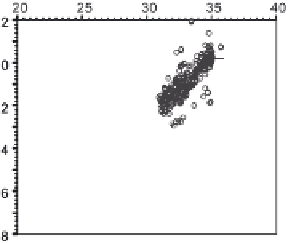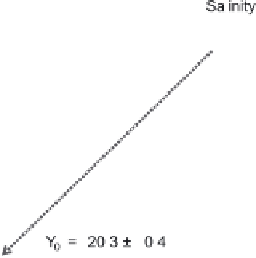Geoscience Reference
In-Depth Information
Figure 8.
Relationship of δ
18
O to salinity in surface and subsurface waters (0-500 m) of the (left) North Atlantic, the
(middle) western Arctic, and (right) scheme of halocline and brine release due to sea ice formation from conceptual
model of
Aagaard
[1981]. Arctic and North Atlantic data are from the Goddard Institute database (available at http://
www.giss.nasa.gov/data/o18data/) [cf.
Schmidt
, 1999;
Bigg and Rohling
, 2000]. In the western Arctic and the northwest
Atlantic, the δ
18
O to salinity distribution defines linear relationships with an apparent freshwater end-member having
an isotopic composition of about −40‰ and −20‰, respectively, which are incompatible with freshwater signatures of
Arctic rivers (mean modern weighted values of approximately −17‰ [cf.
Hélie
et al.
, 2006]) and thus provides evidence
for the impact of sea ice brine distillation processes on isotopic composition of seawater.
during sea ice growth, when the freezing of low-salinity sur-
face water produces isotopically light brines, either sinking
rapidly in the water column or temporarily constrained in
water vacuoles in the ice, whereas sea ice melting results in
the addition of an isotopically heavy, but low-salinity water
to the surface layer (see Figure 8). As already mentioned, the
isotopic enrichment of sea ice with a separation factor near
+3‰ under equilibrium conditions [
O'Neil
, 1968], although
generally unattained because of kinetic and boundary layer
effects when sea ice forms [cf.
Ekwurzel
et al.
, 2001], may
result in a further depletion in
18
O of the residual brines.
As a consequence of the above mentioned converging
processes, sea ice formation provides the only situation lead-
ing to opposite trends of the salinity and δ values relationship
in oceanic water, thus in biogenic carbonates. The interpreta-
tion of the δ
18
O value of foraminifer shells remains difficult
because it also results from thermodependent fractionation
processes. Nevertheless, δ
18
O data in biogenic carbonate
from Arctic environments can be useful inasmuch as they
allow inference about relative rates of sea ice formation.
sedimentation rates [e.g.,
Poore et al
., 1999;
Hillaire-Marcel
et al.
, 2004;
Not
et al.
, 2008] in addition to limited biogenic
contents of sediment. Nevertheless, a few cores close to the
modern limit of the perennial ice in the western Arctic pro-
vided suitable biogenic content for both dinocyst analyses
and stable isotope measurements in foraminifera. Figure 9
shows a Holocene record from the western Arctic, which
is interesting despite its poor stratigraphical resolution, be-
cause it includes dinocyst-based reconstruction of sea ice
cover and δ
18
O in both planktic and benthic foraminifera [cf.
de Vernal
et al.
, 2005a]. The record indicates very large am-
plitude changes during the Holocene, with extensive sea ice
cover during the early Holocene until about 7000 years ago.
The interval from 9000 to 7000 years B.P. is also marked by
particularly low δ
18
O values in
N. pachyderma
. The early
Holocene isotopic data from planktic foraminifera in the
western Arctic have been interpreted as the result of maxi-
mum inflow of warm North Atlantic water characterized by
temperature higher than at present by up to 3°C in the subsur-
face to intermediate water layer [cf.
Hillaire-Marcel et al.
,
2004]. Such an interpretation implied a decoupling between
freezing surface waters and relatively warm intermediate
waters that could also be linked to increased heat accumu-
lation under a capped layer [cf.
Mignot
et al.
, 2007]. Not
exclusive to the above mentioned interpretation, enhanced
rates of sea ice formation in the Arctic with brine rejection
to the top of the pycnocline also likely occurred as illustrated
by the particularly low δ
18
O values in all size classes of the
analyzed planktic foraminifer shells. Thus, together, the
5. eXAMPle OF QUAlITATIVe AND QUANTITATIVe
SeA ICe ReCONSTRUCTIONS
5.1. Western Arctic Holocene Time Series
In the Arctic Ocean areas presently characterized by pe-
rennial ice, the paleoceanographical records of the Holocene
are rare and difficult to interpret because of extremely low



























































Search WWH ::

Custom Search